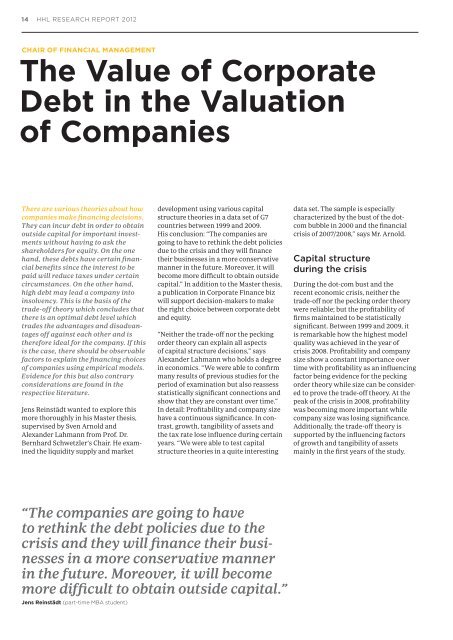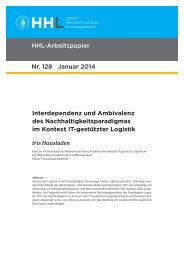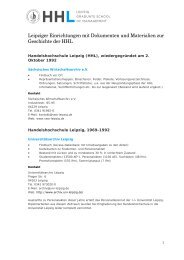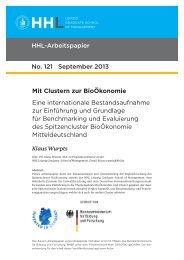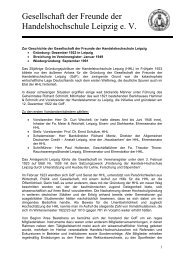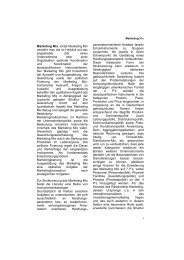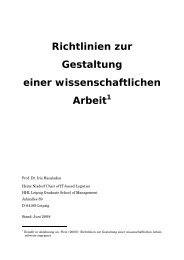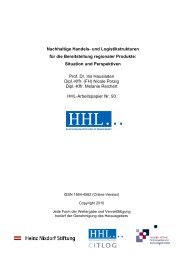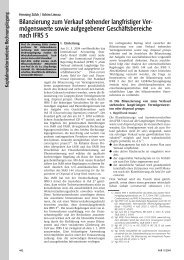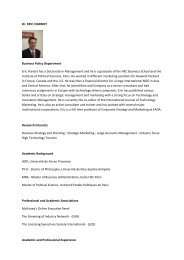Bio- and regenera- tive Medicine as an important growth Market
Bio- and regenera- tive Medicine as an important growth Market
Bio- and regenera- tive Medicine as an important growth Market
Create successful ePaper yourself
Turn your PDF publications into a flip-book with our unique Google optimized e-Paper software.
14 HHL RESEARCH REPORT 2012 finAnCE, ACCOunTing And CORPORATE gOvERnAnCE 15<br />
cHair oF Fin<strong>an</strong>cial M<strong>an</strong>ageMent<br />
the value of corporate<br />
debt in the valuation<br />
of comp<strong>an</strong>ies<br />
There are various theories about how<br />
comp<strong>an</strong>ies make fin<strong>an</strong>cing decisions.<br />
They c<strong>an</strong> incur debt in order to obtain<br />
outside capital for import<strong>an</strong>t investments<br />
without having to <strong>as</strong>k the<br />
share holders for equity. On the one<br />
h<strong><strong>an</strong>d</strong>, these debts have certain fin<strong>an</strong>cial<br />
benefits since the interest to be<br />
paid will reduce taxes under certain<br />
circumst<strong>an</strong>ces. On the other h<strong><strong>an</strong>d</strong>,<br />
high debt may lead a comp<strong>an</strong>y into<br />
insolvency. This is the b<strong>as</strong>is of the<br />
trade-off theory which concludes that<br />
there is <strong>an</strong> optimal debt level which<br />
trades the adv<strong>an</strong>tages <strong><strong>an</strong>d</strong> disadv<strong>an</strong>tages<br />
off against each other <strong><strong>an</strong>d</strong> is<br />
therefore ideal for the comp<strong>an</strong>y. If this<br />
is the c<strong>as</strong>e, there should be observable<br />
factors to explain the fin<strong>an</strong>cing choices<br />
of comp<strong>an</strong>ies using empirical models.<br />
Evidence for this but also contrary<br />
considerations are found in the<br />
respec<strong>tive</strong> literature.<br />
Jens Reinstädt w<strong>an</strong>ted to explore this<br />
more thoroughly in his M<strong>as</strong>ter thesis,<br />
supervised by Sven Arnold <strong><strong>an</strong>d</strong><br />
Alex<strong><strong>an</strong>d</strong>er Lahm<strong>an</strong>n from Prof . Dr .<br />
Bernhard Schwetzler‘s Chair . He examined<br />
the liquidity supply <strong><strong>an</strong>d</strong> market<br />
development using various capital<br />
structure theories in a data set of G7<br />
countries between 1999 <strong><strong>an</strong>d</strong> 2009 .<br />
His conclusion: “The comp<strong>an</strong>ies are<br />
going to have to rethink the debt policies<br />
due to the crisis <strong><strong>an</strong>d</strong> they will fin<strong>an</strong>ce<br />
their businesses in a more conserva<strong>tive</strong><br />
m<strong>an</strong>ner in the future . More over, it will<br />
become more difficult to obtain outside<br />
capital .” In addition to the M<strong>as</strong>ter thesis,<br />
a publication in Corporate Fin<strong>an</strong>ce biz<br />
will support decision-makers to make<br />
the right choice between corporate debt<br />
<strong><strong>an</strong>d</strong> equity .<br />
“Neither the trade-off nor the pecking<br />
order theory c<strong>an</strong> explain all <strong>as</strong>pects<br />
of capital structure decisions,” says<br />
Alex<strong><strong>an</strong>d</strong>er Lahm<strong>an</strong>n who holds a degree<br />
in economics . “We were able to confirm<br />
m<strong>an</strong>y results of previous studies for the<br />
period of examination but also re<strong>as</strong>sess<br />
statistically signific<strong>an</strong>t connections <strong><strong>an</strong>d</strong><br />
show that they are const<strong>an</strong>t over time .”<br />
In detail: Profitability <strong><strong>an</strong>d</strong> comp<strong>an</strong>y size<br />
have a continuous signific<strong>an</strong>ce . In contr<strong>as</strong>t,<br />
<strong>growth</strong>, t<strong>an</strong>gibility of <strong>as</strong>sets <strong><strong>an</strong>d</strong><br />
the tax rate lose influence during certain<br />
years . “We were able to test capital<br />
structure theories in a quite interesting<br />
“The comp<strong>an</strong>ies are going to have<br />
to rethink the debt policies due to the<br />
crisis <strong><strong>an</strong>d</strong> they will fin<strong>an</strong>ce their businesses<br />
in a more conserva<strong>tive</strong> m<strong>an</strong>ner<br />
in the future. Moreover, it will become<br />
more difficult to obtain outside capital.”<br />
Jens reinstädt (part-time MBA student)<br />
data set . The sample is especially<br />
character ized by the bust of the dot-<br />
com bubble in 2000 <strong><strong>an</strong>d</strong> the fin<strong>an</strong>cial<br />
crisis of 2007/2008,” says Mr . Arnold .<br />
Capital structure<br />
during the crisis<br />
During the dot-com bust <strong><strong>an</strong>d</strong> the<br />
recent economic crisis, neither the<br />
trade-off nor the pecking order theory<br />
were reliable; but the profitability of<br />
firms maintained to be statistically<br />
signific<strong>an</strong>t . Between 1999 <strong><strong>an</strong>d</strong> 2009, it<br />
is remarkable how the highest model<br />
quality w<strong>as</strong> achieved in the year of<br />
crisis 2008 . Profitability <strong><strong>an</strong>d</strong> comp<strong>an</strong>y<br />
size show a const<strong>an</strong>t import<strong>an</strong>ce over<br />
time with profitability <strong>as</strong> <strong>an</strong> influencing<br />
factor being evidence for the pecking<br />
order theory while size c<strong>an</strong> be considered<br />
to prove the trade-off theory . At the<br />
peak of the crisis in 2008, profitability<br />
w<strong>as</strong> becoming more import<strong>an</strong>t while<br />
comp<strong>an</strong>y size w<strong>as</strong> losing signific<strong>an</strong>ce .<br />
Additionally, the trade-off theory is<br />
supported by the influencing factors<br />
of <strong>growth</strong> <strong><strong>an</strong>d</strong> t<strong>an</strong>gibility of <strong>as</strong>sets<br />
mainly in the first years of the study .<br />
They are not const<strong>an</strong>t over time <strong><strong>an</strong>d</strong><br />
lose signific<strong>an</strong>ce with the crisis of the<br />
New Economy with t<strong>an</strong>gibi lity of <strong>as</strong>sets<br />
even becoming a nega<strong>tive</strong> factor prior to<br />
the crisis, which supports the pecking<br />
order theory . However, this trend h<strong>as</strong><br />
not continued . Moreover, the pecking<br />
order theory does explain the fin<strong>an</strong>cing<br />
choice of large comp<strong>an</strong>ies throughout<br />
the entire period very well . Since the<br />
present study provides arguments for<br />
both theories during various periods,<br />
it c<strong>an</strong> be <strong>as</strong>sumed that the trade-off<br />
<strong><strong>an</strong>d</strong> pecking order theory each explain<br />
a part of the capital structure decision<br />
making <strong><strong>an</strong>d</strong> complement one <strong>an</strong>other .<br />
“Interesting is the fact that industry<br />
membership is a very import<strong>an</strong>t determin<strong>an</strong>t<br />
of leverage . This is <strong>an</strong> indicator<br />
that comp<strong>an</strong>ies position themselves<br />
with respect to their own peer group,”<br />
says Alex<strong><strong>an</strong>d</strong>er Lahm<strong>an</strong>n .<br />
From this finding, the authors derive<br />
further questions for scientific research:<br />
are there cyclical economic schematics<br />
in the industries or are there industryspecific<br />
characteristics which we have<br />
not understood yet? In <strong>an</strong>y c<strong>as</strong>e, the<br />
<strong>as</strong>set t<strong>an</strong>gibility variable becomes insignific<strong>an</strong>t<br />
when including industries into<br />
the empirical model .<br />
Another result of the data <strong>an</strong>alysis:<br />
prior to the fin<strong>an</strong>cial crisis, comp<strong>an</strong>ies<br />
worldwide were not excessively in debt .<br />
“The common statement in the public<br />
debate that excessive debt led to the<br />
crisis is refuted in our global data set of<br />
capital market comp<strong>an</strong>ies,” says Sven<br />
Arnold, who holds a degree in mathematics<br />
. No differences in the development<br />
of the debt ratio were me<strong>as</strong>ured<br />
in the individual countries during the<br />
crises . Generally, C<strong>an</strong>ada <strong><strong>an</strong>d</strong> Germ<strong>an</strong>y<br />
have the lowest, Jap<strong>an</strong> <strong><strong>an</strong>d</strong> Italy the<br />
highest debt ratio over the entire study<br />
period .<br />
cHair oF Fin<strong>an</strong>cial M<strong>an</strong>ageMent<br />
tax Shield – a topic in<br />
practice <strong><strong>an</strong>d</strong> Science<br />
The value of outside fin<strong>an</strong>cing h<strong>as</strong><br />
always been a crucial question of<br />
economics which could only be<br />
<strong>an</strong>swered with <strong>as</strong>sumptions far from<br />
reality up to now . The question h<strong>as</strong><br />
been <strong>as</strong>ked <strong><strong>an</strong>d</strong> ac<strong>tive</strong>ly discussed<br />
since the 1960s . However, the work of<br />
Prof . Dr . Bernhard Schwetzler, Sven<br />
Arnold <strong><strong>an</strong>d</strong> Alex<strong><strong>an</strong>d</strong>er Lahm<strong>an</strong>n takes<br />
<strong>an</strong> adv<strong>an</strong>ced look at this valuation<br />
problem in Germ<strong>an</strong>y . They examine<br />
the value of tax shields with particular<br />
consideration towards insolvency <strong><strong>an</strong>d</strong><br />
the value of the interest barrier .<br />
Glossary<br />
tax Shield<br />
A tax shield is the reduction in income taxes that<br />
results from taking <strong>an</strong> allowable deduction from<br />
taxable income. Since a tax shield is a way to<br />
save c<strong>as</strong>h flows, it incre<strong>as</strong>es the value of the<br />
business, <strong><strong>an</strong>d</strong> it is <strong>an</strong> import<strong>an</strong>t <strong>as</strong>pect of<br />
business valuation.<br />
“In general, we deal with the value<br />
proposition of outside capital in the<br />
valuation of comp<strong>an</strong>ies,” says economist<br />
Alex<strong><strong>an</strong>d</strong>er Lahm<strong>an</strong>n . The interest<br />
on lo<strong>an</strong>s taken out by comp<strong>an</strong>ies<br />
being tax-deductible in the calculation<br />
of the <strong>an</strong>nual net income leads to<br />
tax benefits from outside fin<strong>an</strong>cing .<br />
“This tax shield is a considerable part<br />
of the market value of a comp<strong>an</strong>y,”<br />
he adds . Empirical studies showed<br />
that it accounts for 10 percent of the<br />
entire comp<strong>an</strong>y value on average . This<br />
value proposition may decre<strong>as</strong>e when<br />
including various conditions in the<br />
examinations such <strong>as</strong> insolvency or<br />
limitations on interest deductibility .<br />
The background: the 2008 comp<strong>an</strong>y<br />
tax reform introduced the limitation<br />
on the tax deductibility of interest<br />
paid, the so-called interest barrier .<br />
The legislature sought to lower the<br />
fiscal incen<strong>tive</strong> of outside fin<strong>an</strong>cing .<br />
“The regulation w<strong>as</strong> to prevent<br />
excessive fin<strong>an</strong>cing through borrowing<br />
by Germ<strong>an</strong> comp<strong>an</strong>ies . It resulted<br />
in a number of critics from the practice<br />
raising their voices to warn<br />
about signific<strong>an</strong>t losses in value by<br />
the comp<strong>an</strong>ies affected,” explains<br />
Prof . Dr . Schwetzler . Therefore he,<br />
together with his two colleagues,<br />
examined the economic effects of this<br />
tax barrier regulation for comp<strong>an</strong>y<br />
owners . The objec<strong>tive</strong> w<strong>as</strong> to determine<br />
the tax benefits resulting from<br />
outside fin<strong>an</strong>cing (tax shield) when<br />
applying this new tax regulation .<br />
The result: the application of the<br />
model set up for the <strong>as</strong>sessment of<br />
tax benefits on the empirical data for<br />
Germ<strong>an</strong> comp<strong>an</strong>ies from the Prime<br />
All Index showed that the value proposition<br />
of the tax barrier is negligible .<br />
The recommended procedure for<br />
practitioners therefore is to consider<br />
the tax barrier solely in<br />
extreme c<strong>as</strong>es <strong><strong>an</strong>d</strong> to take into<br />
account the insolvency probability<br />
when <strong>as</strong>sessing tax benefits .<br />
Prof . Dr . Schwetzler sees relev<strong>an</strong>ce<br />
in this project both for the practice<br />
<strong><strong>an</strong>d</strong> for science . “In the practice, you<br />
w<strong>an</strong>t to know whether you should<br />
indeed model the interest barrier<br />
<strong><strong>an</strong>d</strong> insolvency in the valuation of a<br />
comp<strong>an</strong>y . The scientists, on the other<br />
h<strong><strong>an</strong>d</strong>, w<strong>an</strong>t to know how to technically<br />
realize these problems .”<br />
Mathematici<strong>an</strong> Sven Arnold says<br />
about the research process: “One<br />
difficulty w<strong>as</strong> to connect a theoretically<br />
correct point of view with reality<br />
. It w<strong>as</strong> the excellent cooperation<br />
between theoretical st<strong><strong>an</strong>d</strong> points<br />
<strong><strong>an</strong>d</strong> certain modeling techniques<br />
which greatly contributed to the<br />
solution of the scientific question .”<br />
The research topic required various<br />
types of expertise: comp<strong>an</strong>y<br />
valuation, model-b<strong>as</strong>ed theoretical<br />
work, knowledge on stoch<strong>as</strong>tic<br />
processes <strong><strong>an</strong>d</strong> implementation in<br />
a computer program . By combining<br />
various abilities it became possible<br />
to <strong>an</strong>alyze these questions .


